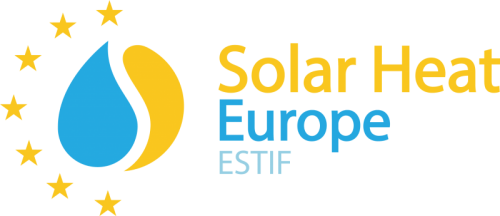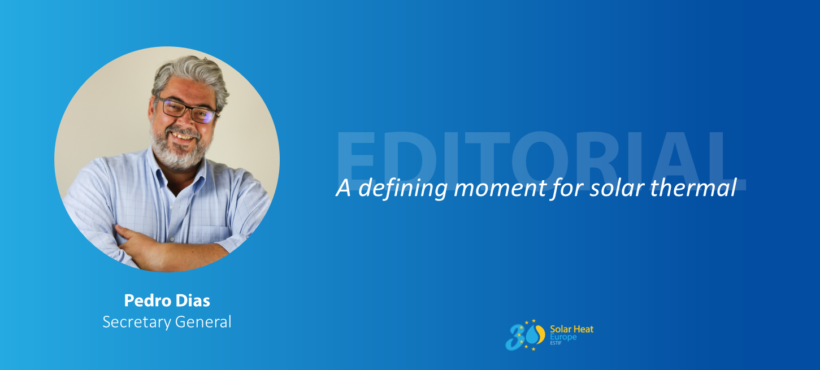We are living exceptional times for our sector. I joined ESTIF in 2008, which represents until today the record year for our sector in terms of annual sales. Since then, we have been through a challenging decade. Right at the end of that decade, the subprime crisis started, bringing an enormous impact on the European economy. In the meantime, the first Renewable Energy Directive was launched, marking a watershed moment for renewable electricity, in particular wind and solar photovoltaics (PV). Feed-in-tariffs (FiT), with its advantages and defects, made the investment in solar PV an extremely profitable financial investment. When one could say that it would be impossible for other technologies, out of the FiT regime and hostile to the business model of the large utilities, solar thermal persevered.
The following decade started a roller coaster for renewables, including solar thermal. The feed-in-tariff model continued to grow, making itself noticeable in consumers’ electricity bills and leading to raising concerns about the costs of renewables. Not surprisingly, this debate was fuelled by strong lobbies, building up on the criticism of renewables. These doubts about RES, together with the persisting effects of the subprime crisis, managed to lower the public support for renewables. With 2020 approaching, it was time to revise the European Directives related to energy, including the Renewable Energy Directive, in what was defined as the Clean Energy Package. While the political context was not the most beneficial, the new Package brought progressive measures, in particular for renewable heating and cooling (RES-HC), which was better addressed, including an unprecedented indicative national target for the uptake of RES-HC. This was possible thanks to the work of several trade associations in Brussels, including Solar Heat Europe, which strived to put the topic on the agenda, leading to the European Commission developing a Heating and Cooling Strategy, which served as the basis for several measures laid-out in the Clean Energy Package.
After that, we saw an increase in national support measures for renewable heating and cooling, from which solar thermal also benefited. Since 2018 we have seen a growth of the year-on-year solar thermal sales in Europe, with the obvious exception of 2020. Preliminary data for 2021, available to SHE’s members, indicates that in 2021, the market had a double-digit growth. While enjoying growth in the market, we are still in the implementation phase of the Clean Energy Package, and we are in the middle of reviewing relevant European Directives meant to increase ambition towards decarbonisation.
This urge for an increased ambition comes from the need to address two major crises that the EU is facing: the climate crisis and the energy security crisis.
It was only in 2018 that Greta Thunberg started what became known as the Friday’s for Future movement. This youth led initiative played an essential role in bringing climate change to the primetime news and to the political agenda. This was complemented by an increased support for the agenda of Green Parties in several European countries and in the European Parliament elections of 2019. The new President of the European Commission, Ursula von der Leyen, and her college made climate the main priority of their mandate. With the European Climate Law and the European Green Deal, they reopened the discussion about increasing the EU’s efforts towards decarbonisation. We are again living a hype for renewables and energy efficiency in Europe. For some time, it seemed that this could be game-over for fossil fuels, namely gas. A counter-reaction was expected, and it came strong! When gas was at risk of being penalised in the EU Taxonomy for Sustainable Activities, an energy price crisis conveniently arose, with a, so-called, “perfect storm”. Low gas reserves in Europe, reduced supply from Russia, nuclear plants under maintenance, and other factors led to an increase in the price of gas and electricity in Europe. This crisis was used by many, including some national governments, to challenge the EU’s climate ambition and to blame renewables for the referred crisis. And somehow the gas lobby managed to turn the table in their favour.
In comes Vladimir Putin, invading Ukraine, unleashing a humanitarian, geopolitical, economic, and energy security crisis in Europe. The urgency to break ties with Russia comes to the forefront of the political agenda. And this means finding alternatives to the Russian gas supply, including renewables.
This week’s announcement by the European Commission of the REPowerEU Plan is an urgent effort to address the energy security crisis. The plan, together with the EU Solar Energy Strategy (launched simultaneously), mark a new era for solar technologies, both for solar photovoltaics and for solar heating and cooling. In order to reduce dependency on fossil fuel imports, the European Commission presented the REPowerEU plan, including an increased target for renewables (45%), a ground-breaking Solar Rooftop Initiative, and measures on permitting, encouraging a large-scale skills partnership under the Pact for Skills.
The EU Solar Energy Strategy contains essential measures for the solar sector. While there is an unsurprising highlight on solar PV, most of the measures are addressing both solar electricity and solar heat technologies, with the EU Solar Rooftop Initiative and the reference to a reduced VAT rate as an example. The solar heat sector needs to proclaim in a loud and sound manner that this is also “our” strategy. We have to contribute to the awareness of policymakers, media, and different stakeholders, that this is a strategy for Solar, not only solar PV.
The EU Solar Energy Strategy stresses the need to triple the current level of heat generation capacity from solar thermal by 2030, which equates to surpassing 110 GWth of solar heat in Europe. It also contains other measures to facilitate the quick deployment of available solutions that can provide renewable heat in EU’s buildings and industries.
And we must highlight that it also points out that, “through support policies and regulations that provide a level playing field for all solar technologies and do not favour one against the other, national and local authorities can promote the most efficient solution for each situation.”
While there are important measures on permitting or financing, the initiative that will take the spotlight is the Solar Rooftop Initiative. We address this in more detail in a specific article about the EU Solar Energy Strategy.
Of course, this is the proposal from the Commission and now we need to work to ensure that it gets support from both the European Parliament and European Council. This will be our priority for the coming period, including our High-Level Event on the 20th of June in Brussels: Heat decarbonisation: a strategic imperative for the EU. We invite you to join us and to contribute to make our sector a central player in the decarbonisation of heat in Europe, be it for buildings, districts, or industries.
At the same time, we will be celebrating the past, the 30 years of ESIF, ESTIF and now Solar Heat Europe and the roller coaster ride we have all been part of. But more importantly, we will be celebrating the future of solar heating and cooling in Europe.
Join us for this ride!


Leave a Reply